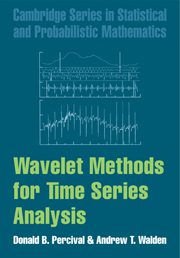Book contents
- Frontmatter
- Contents
- Preface
- Conventions and Notation
- 1 Introduction to Wavelets
- 2 Review of Fourier Theory and Filters
- 3 Orthonormal Transforms of Time Series
- 4 The Discrete Wavelet Transform
- 5 The Maximal Overlap Discrete WaveletTransform
- 6 The Discrete Wavelet Packet Transform
- 7 Random Variables and StochasticProcesses
- 8 The Wavelet Variance
- 9 Analysis and Synthesis of Long MemoryProcesses
- 10 Wavelet-Based Signal Estimation
- 11 Wavelet Analysis of Finite EnergySignals
- Appendix. Answers to Embedded Exercises
- References
- Author Index
- Subject Index
4 - The Discrete Wavelet Transform
Published online by Cambridge University Press: 05 December 2013
- Frontmatter
- Contents
- Preface
- Conventions and Notation
- 1 Introduction to Wavelets
- 2 Review of Fourier Theory and Filters
- 3 Orthonormal Transforms of Time Series
- 4 The Discrete Wavelet Transform
- 5 The Maximal Overlap Discrete WaveletTransform
- 6 The Discrete Wavelet Packet Transform
- 7 Random Variables and StochasticProcesses
- 8 The Wavelet Variance
- 9 Analysis and Synthesis of Long MemoryProcesses
- 10 Wavelet-Based Signal Estimation
- 11 Wavelet Analysis of Finite EnergySignals
- Appendix. Answers to Embedded Exercises
- References
- Author Index
- Subject Index
Summary
Introduction
Here we introduce the discrete wavelet transform (DWT), which is the basic tool needed for studying time series via wavelets and plays a role analogous to that of the discrete Fourier transform in spectral analysis. We assume only that the reader is familiar with the basic ideas from linear filtering theory and linear algebra presented in Chapters 2 and 3. Our exposition builds slowly upon these ideas and hence is more detailed than necessary for readers with strong backgrounds in these areas. We encourage such readers just to use the Key Facts and Definitions in each section or to skip directly to Section 4.12 – this has a concise self-contained development of the DWT. For complementary introductions to the DWT, see Strang (1989, 1993), Rioul and Vetterli (1991), Press et al. (1992) and Mulcahy (1996).
The remainder of this chapter is organized as follows. Section 4.1 gives a qualitative description of the DWT using primarily the Haar and D(4) wavelets as examples. The formal mathematical development of the DWT begins in Section 4.2, which defines the wavelet filter and discusses some basic conditions that a filter must satisfy to qualify as a wavelet filter. Section 4.3 presents the scaling filter, which is constructed in a simple manner from the wavelet filter. The wavelet and scaling filters are used in parallel to define the pyramid algorithm for computing (and precisely defining) the DWT – various aspects of this algorithm are presented in Sections 4.4, 4.5 and 4.6.
- Type
- Chapter
- Information
- Wavelet Methods for Time Series Analysis , pp. 56 - 158Publisher: Cambridge University PressPrint publication year: 2000
- 3
- Cited by



